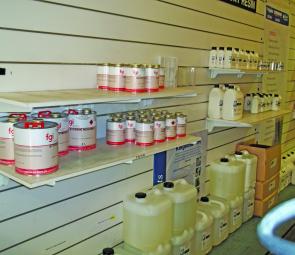Hi again and thank you so much for all the great feedback on the three part series on tools. Thanks also for bearing with me; I really wanted to cover as much as possible in that area. There will be other tools and bits and pieces that I will explain along the way as I cover specific projects.
Over the next few issues I’ll be covering the products required for your boat repairs. The most critical part of your boat is the structural, cosmetic fibreglass and gel coat components. If you keep these in ship-shape condition then your boat will last a whole lot longer. So whether you are just cutting and polishing or fibre glassing a new floor in your boat, it needs to be done correctly with the right products.
Knowledge in this area is important as this is where it can get costly if there is a lack of accuracy when it comes to various ratios and applications.
In this issue I’m going to cover gel coat resins. Please note that I don’t have any secrets on the products I use nor do I get any kick backs from suppliers. I only use products that are successful in achieving the best results possible. All the advice I will offer is strictly from trial and error.
Fibreglass was first developed in the mid 1940s and was the first composite used, which is still to this day the most common. Glass fibre reinforced plastic or FRP consists of two distinct materials – fibres of glass, which is the reinforcement, and polymer resin called polyester. The polyester is brittle and has very little strength but when the glass fibres are added it becomes strong. It is light and has the ability to withstand sudden blows without breaking.
There is quite a large choice of resins on the market but the two most common we use are waxed and unwaxed polyester. I use unwaxed purely for the adhesion rate and the bonding properties are far superior. Also the window you have in prep time between laminate schedules is much better.
There are two types of bonds – a chemical bond and a secondary bond. A chemical bond is a laminate all done in the one application. A secondary bond is a process where you are applying more glass and resin over an already cured surface. So unless you have big dags, you can apply the next layer without grinding, as long as you are in the window time.
Waxed and unwaxed resins are both in a saturated form, which means that the resin is capable of being cured from a liquid to a solid with a hardener called catalyst - this process is called polymerisation.
Epoxy is an alternative resin and is used for its differing properties. It has higher performance and elongation, and is stiffer and more water proof than polyesters. It’s less brittle and a very strong yet lightweight resin with greater bonding and adhesion properties, especially when using fabric materials such as steel and timber. It also has a far better chemical resistance, but is a lot more expensive.
Epoxy is normally the preferred resin in the speed boat and high performance markets as it makes a great combination with high tensile fabrics and again is a very light weight product.
As always safety must come first, so use the right safety products when applying epoxy and any other chemical for that matter. With epoxy, everybody is allergic to it but we all have different tolerance levels and an allergic reaction may occur, so be sure to use gloves at all times.
I will cover gelcoat/flowcoat, fillers and the solvents used to clean you and your tools in the next issue. So stay tuned for a bit more info on the sticky stuff next month.
Reads: 4847
There are many different resin products available to those undertaking a fibreglassing job.

Choosing the right resin is important to the end product, get good advice and good luck.




